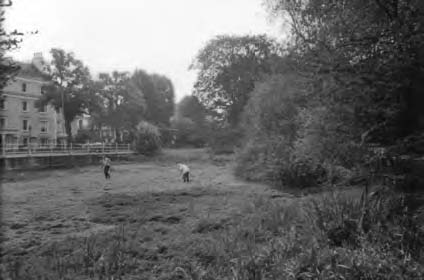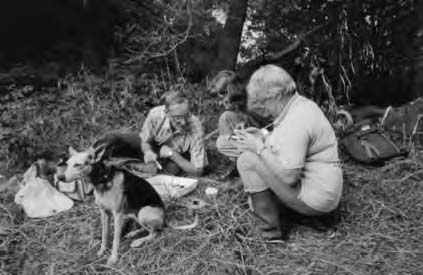|
A joint field meeting of the London Natural History Society and the Conchological Society of Great Britain and Ireland was held on 16 September 2006 with 12 members and friends and Dingo (London Natural History Society dog) present. The aim of the meeting was to record molluscs on Wimbledon Common for the conservators who manage the Common. June Chatfield produced a spread sheet of incidental mollusc records made from her excursions with the South London Botanical Institute since 2000 and also extracted from the book Wimbledon Common & Putney Heath: a Natural History edited by Tony Drakeford and Una Sutcliffe and published by the Conservators in 2000 (ISBN 0950 1887 5 1). The list consisted of 2l species of molluscs. Wimbledon Common is an oasis of seminatural open space in a built-up area of south London. In the 1860s it had a narrow escape from housing development but this plan was thwarted by the action of local residents leading to the passing of the Wimbledon and Putney Commons Act 1871 when the Common came into the hands of the Conservators. Since then it has been managed for wildlife and recreation and is a much valued green space as well as being heathland, a habitat that is rare in the London area. Wimbledon Common is an SSSI. The new Visitor’s Centre near the windmill and Warden’s Office has exhibits on the history and natural history of the Common, a copy of the book for reference and a microscope with large viewing screen that can be used to examine specimens, as we did for a problematical ram’s-horn (Gyraulus laevis) that needed more than a hand lens to determine. Wimbledon Common is on an elevated site and the bedrocks are Tertiary deposits mostly of London Clay and Claygate Beds, overlain in places by Thames terrace gravel — hence the heathland habitat. Soils are acidic except in some local areas near the edge where road materials have been deposited in the past and some artificial mounds made. The various ponds on the common are all man-made being derived from earlier gravel digging. Habitats include heathland (wet and dry), mixed and deciduous woodland (oak and birch), mounds of imported material, ponds, and at the south side, springs draining into the Beverley Brook, a tributary of the Wandle. We did not reach the southern part. The geology, habitats, flora and fauna are further explained in the book (Drakeford & Sutcliffe 2000) and in displays on site in the Visitor Centre. The Common is a vast area and mollusc hunting a slow business, so we only explored a small area, leaving the rest for a future meeting. The 1 km grid squares that we worked were TQ/22-72 and TQ/23-73-. Our field work extended into some entomology particularly water beetles and caterpillars of moths. Seven-Post Pond is by the road on the northern part of the Common known as Putney Heath and is the best pond for molluscs, having a slightly higher pH of 6.6 recorded in the survey of 1996 (Drakeford & Sutcliffe 2000). In September 2006, due to the dry summer there was little standing water and the basin of the pond was covered by a mat of the alien pondweed Crassula helmsii. This proved a good protection for the water life left otherwise exposed. The low water level enabled us to reach the centre of the pond and to do a more effective survey. We confirmed the continuation of living populations of the Common Pond Snail (Radix balthica), Great Pond Snail (Lymnaea stagnalis), Great Ram’s- horn (Planorbarius corneus). The Ram’s-horn (Planorbis planorbis or possibly the similar species P. carinatus), River Snail (Viviparus contectus) and the Horny Orbshell (Sphaerium corneum agg.) that were recorded in 1996. Closer examination by Peter Wilson of the Planorbis suggested that it might be the Keeled Ram’s-horn (P. carinatus) on account of its colour and glossy shell but these two are notoriously difficult to separate. We also confirmed the continuation of the alien Pointed Bladder Snail (Physella acuta) that I had found in the pond in April 2005. The Bladder Snails are adapted to habitats that dry up and I met them in swamp woodlands in Michigan USA in 1974. We were able to add some species to the existing list, but none of them were in large numbers. Small bivalves are often overlooked on account of difficulty of identification and the need to take some back for microscope work. Peter Wilson found the Lake Orb- shell (Musculium lacustre) and Rosemary Hill found the even smaller Porous-shelled Pea Mussel (Pisidium obtusale). The most exciting find (one living and one shell) was the Smooth Ram’s-horn (Gyraulus laevis): it is much like the common White Ram’s-horn but lacks the spiral lines on the shell. It is a very local species and the Atlas of Land and Freshwater Molluscs by Michael Kerney (Harley Books 1999) shows no recent records for the London area and no previous record for Wimbledon. It is however a coloniser of gravel pit lakes, which is the early history of Seven-Post Pond. We also found a shell of another Ram’s-horn (Hippeutis complanatus). The other species of note is the River Snail (Viviparus contectus). This is recognised by the deep sutures or grooves between the whorls of the shell and unlike the other water snails this is a gill-breathing prosobranch mollusc in which the mouth of the shell is closed by an operculum or hard plate on the back of the foot. It is a part of the living mollusc and grows with it, hence the concentric lines. The River Snail is of local distribution in canals and drainage ditches of central and eastern England and is in the Thames. This record was included in the Atlas (Kerney 1999). The Thames valley is the southern boundary of its range in Britain, except for a cluster of records in Somerset. Some terrestrial species were recorded around the edge of the pond: they were the Great Slug (Arion ater agg.), Hedgehog Slug (A. intermedius) that hunches up into a hedgehog shape and has upstanding tubercles, Leopard Slug (Limax maximus) that is often spotted, Common Garden Snail (Cornu aspersum), Slippery Moss Snail (Cochlicopa lubrica) and the Garlic Glass Snail (Oxychilus alliarius). The Garlic Snail is flat, shiny, brown and small (6mm across) but gives off a strong smell of garlic when prodded with a piece of grass stem. Once encountered, always remembered: it is a popular party trick. The garlic smell has been shown to be a defence against snail-eating beetles. Kingsmere This was a much larger pond, more a lake, of pH 6.0, with sandy bottom, no water weed and water birds including geese. Both the lake and its margins were very unproductive, yielding only the Pointed Bladder Snail (Physella acuta) that had probably taken a lift on a bird from Seven- Post Pond and the Kentish Snail (Monacha cantiana), surprisingly, by the margin. A damp grassy hollow near Kingsmere examined with noses to the ground yielded the Rayed Glass Snail (Nesovitrea hammonis) all of 4 mm, more Garlic Glass Snails (Oxychilus alliarius) and Hedgehog Slug (Arion intermedius), an assemblage typical of acidic wet grass. The Mounds The last search of the morning was on the mounds of made-up ground where we found the Waxy Glass Snail (Aegopinella nitidula), the Pellucid Glass Snail (Vitrina pellucida), another Hedgehog Slug. the tiny Eccentric Grass Snail (Vallonia excentrica) only 2.5 mm across that is typical of calcareous grassland and examples of the Brown-Lipped Snail (Cepaea nemoralis). This has been found elsewhere on the Common. From here we made our way back to the windmill for lunch. Queensmere and surrounding woodland The afternoon session began with an investigation of Queensmere, another acid lake of pH 6.3 and a poor habitat for molluscs. The Pointed Bladder Snail was found and, after a good deal of effort, the Shining Pea Mussel (Pisidium nitidum). The woodland alongside was equally unproductive yielding only Oxychilus alliarius. After a recreational interlude, cheering Dingo in her outpacing of other dogs in retrieving their sticks in the water, we followed Stag Ride in a south-westerly direction. Stag Ride Here we found Waxy Glass Snail (Aegopinella nitidula), Brown-lipped Snail (Cepaea nemoralis), Common Garden Snail (Cornu aspersum) and the Common Grey Field Slug (Deroceras reticulatum). A yellowish Limax slug was seen but disappeared in a crevice in the wood. The abundance of dead wood and logs along the ride provided valuable habitats for slugs and snails. The final tally was 24 species of molluscs, mostly confirming old records, but including some new ones. Pond Life Pam Wilson from the Conchological Society added the following records for Seven-Post Pond: the flatworm Polycelis tenuis, leech Erpobdella octoculata, crustaceans, the American Pond Shrimp (Crangonyx pseudogracilis), Water Louse (Asellus aquaticus), bugs Plea leachii and Saucer Bug (Ilyocoris cimicoides), Soldier Fly larva (Stratiomys chamaeleon) and water beetles (Haliplus ruficollis ruficollis, Noterus clavicornis, Hydrochus angustatus, Helochares punctatus and Enochrus coarctatus). Additional species for Queensmere were: leeches Hemiclepsis marginata that feeds on fishes and amphibians and Helobdella stagnalis, Water Louse (Asellus aquaticus) and the fish Tench. Insects Two very attractive caterpillars were found in the vicinity of Queensmere and were identified by Rosemary Hill and Ron Boyce as the moths Kent Black Arches (Meganola albula) and Bright-line Brown-eye (Lacanobia oleracea). It was an enjoyable and interesting day and the Warden, Dave Haldane, has written to thank us for the records. Pond surveys at Nonsuch Park, Ewell, Surrey on Saturday 28 April 2007 Members of the Conchological Society are invited to another field meeting of the The London Natural History Society, this one jointly with the conservation group Nonsuch Watch, to investigate the freshwater life of the various ponds in Nonsuch Park. It starts at 10.30. bring lunch. Meet at the Ewell gate car park (off A24 near Briarwood Road) for Nonsuch Park (TQ/226634). Leaders June Chatfield (Tel: 01420 82214) and Mick Massie (mick.massie@gmail.com). |
1. Pam and Peter Wilson investigating the centre of Seven-Post Pond, Wimbledon Common. Photo: June Chatfield
2. Examining the catch at Seven-Post Pond with Dingo looking elsewhere. Wimbledon Common. Photo: June Chatfield
3. Examining the catch at Seven-Post Pond, Wimbledon Common. Photo: June Chatfield
4. June Chatfield showing Viviparus contectus to the group. Wimbledon Common Photo: Ron Boyce |
Wimbledon Common with the London Natural History Society, September 2006
Issue
13
Page
24




